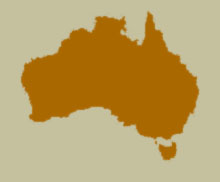Synonyms
Orcus coelestris Blackburn, 1891: 153.
Orcus ovalis Blackburn, 1892: 241.
Orcus splendens Blackburn, 1892: 240.
Orcus clypeatus Weise, 1923: 133.
Diagnosis
This is a very distinctive species due to the presence of an obvious straight anterior border on the clypeus.
Description
Length 2.5-3.9 mm. Dorsal surface metallic bluish or greenish. Venter pale brownish, except thoracic and first abdominal ventrites, which are dark brownish. Body slightly elongate, somewhat flattened. Head polished to weakly micro reticulate between punctures; punctation about as large as eye facets, nearly 1.5 diameters apart. Eyes dorsally separated by slightly more than 2 times the width of an eye; inner ocular margin slightly diverging apically. Antennomere 6 about 1.5 times longer than 5th and 7th. Clypeus straight, anteriorly bordered with lateral extension not conspicuously narrow. Terminal maxillary palpomere securiform; terminal labial palpomere conical; less than 2 times longer than basal width; as long as the preceding segment. Pronotal surface polished between punctures; punctation smaller than eye facets, approximately 2 diameters apart; obsolete on anterior angles; lateral borders slightly rounded. Prosternum relatively long in front of coxae, about 2 times longer than prosternal process widest width. Elytral surface polished between punctures; punctation stronger than on pronotum, about as large to larger than eye facets, slightly deeper; lateral margin slightly reflexed. Abdomen with ventrite 6 conspicuous, shortly emarginate at apex; surface of ventrite 1 polished between postcoxal lines; postcoxal line usually straight but sometimes recurving apically.
Male
Tegmen relatively long, about 3/4 the abdomen length; penis guide symmetrical, slightly longer than parameres; parameres densely setose at apex, the setae long; strut as long as tegmen; penis as figured.
Female
Externally identical to male.
Variation
Not observed.
 Distribution and Biology
Distribution and Biology
Widely distributed in Australia and New Guinea.
Species References
Blackburn, T. 1891. Further notes on Australian Coleoptera, with descriptions of new genera and species. IX. Transactions of the Royal Society of South Australia, 14: 65-153. Blackburn, T. 1892. Further notes on Australian Coleoptera, with descriptions of new genera and species. XII. Transactions of the Royal Society of South Australia, 15: 207-361.
Slipinski, S.A. 2007. Australian Ladybird Beetles (Coleoptera: Coccinellidae) their biology and classification. ABRS, Canberra. 286 pp.
Slipinski, A. and Giorgi, J.A. 2006. Revision of the Australian Coccinellidae (Coccinellidae). Part 6. Tribe Chilocorini. Annales Zoologici (Warszawa), 56(2): 265-304.
Weise, J. 1923. Results of Dr. E. Mjöbergís Swedish Scientific Expedition to Australia 1910-1913. 31. Chrysomeliden und Coccinelliden aus Queensland. Arkiv för Zoologi, 15(12): 1-150.[ Top ]
